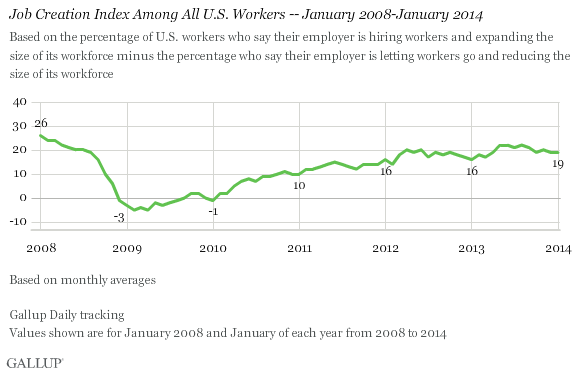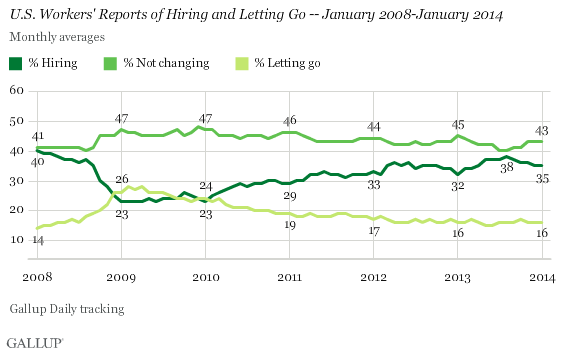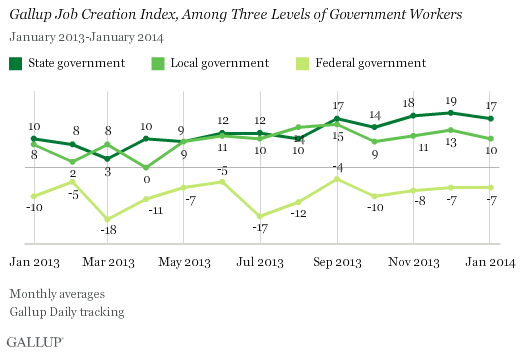WASHINGTON, D.C. -- Gallup's Job Creation Index registered +19 in January, unchanged from the prior month. This score is a three-point improvement from January 2013 and is on par with the overall 2013 average of +20.

The index is a measure of net hiring in the U.S., based on a nationally representative sample of more than 17,000 full- and part-time workers. The index for January reflects the difference between the 35% of Americans who said their employer is hiring workers and expanding its workforce and the 16% of workers who said their employer is letting workers go and reducing the size of its workforce.
Since the 2008-2009 recession ended in June 2009, the percentage of U.S. workers saying their employer is hiring has gradually improved, while the percentage reporting layoffs and firings has declined. The percentage of workers who said their employer was hiring workers fell to a low of 23% in 2009 and early 2010, and climbed to its post-recession high of 38% in August 2013. Workers reporting layoffs at their jobs peaked at 28% in February and April 2008, and has settled down in the 15% to 17% range over the past two years. The percentage of American workers who say their employer is not changing the size of its workforce has been stable in the low to mid-40% range.

Government Hiring Essentially Unchanged in January
Government workers' reports of net hiring declined two points in January from December 2013, but that change is not statistically significant. January's score of +8 is an improvement from January 2013's +4 score and is three points higher than the overall 2013 monthly average of +5. From a broader perspective, 2013 was the first year since Gallup began measuring hiring monthly in 2008 that the average index for the government was in positive territory.

State and local government workers continue to report a more positive hiring situation at their workplaces than do federal government workers. The net hiring score among state workers was +17 in January, while it was +10 among local government employees. Meanwhile, the net hiring score among federal government workers was -7, which represents 30% of federal government workers reporting increases in hiring, and 37% reporting firings and layoffs. In 2009 and 2010, the government situation was the reverse: the net hiring score among federal government workers was positive, while it was negative among state and local government workers.

Implications
Gallup's Job Creation Index has improved since the depths of the 2008-2009 recession, but it has leveled off in recent months. The index still has not returned to levels found in early 2008.
Hiring in the private sector remains much stronger than in the government sector, and the federal government in particular has the worst hiring situation. The recent bipartisan budget deal seeks to relax some of the damaging cuts of sequestration, with Congressional Budget Office projections showing federal outlays increasing by roughly 3% in 2014. This may contribute to better hiring conditions in the federal government in the near future.
Gallup.com reports results from these indexes in daily, weekly, and monthly averages and in Gallup.com stories. Complete trend data are always available to view and export in the following charts:
Daily: Employment, Economic Confidence, Job Creation, Consumer Spending
Weekly: Employment, Economic Confidence, Job Creation, Consumer Spending
Read more about Gallup's economic measures.
View our economic release schedule.
Survey Methods
Results for this Gallup poll are based on telephone interviews conducted Jan. 2-31, 2014, on the Gallup Daily tracking survey, with a random sample of 17,484 adults, aged 18 and older, who are employed full or part time, living in all 50 U.S. states and the District of Columbia.
For results based on the total sample of employed adults, the margin of sampling error is ±1 percentage point at the 95% confidence level.
Interviews are conducted with respondents on landline telephones and cellular phones, with interviews conducted in Spanish for respondents who are primarily Spanish-speaking. Each sample of national adults includes a minimum quota of 50% cellphone respondents and 50% landline respondents, with additional minimum quotas by time zone within region. Landline and cellular telephone numbers are selected using random-digit-dial methods. Landline respondents are chosen at random within each household on the basis of which member had the most recent birthday.
Samples are weighted to correct for unequal selection probability, nonresponse, and double coverage of landline and cell users in the two sampling frames. They are also weighted to match the national demographics of gender, age, race, Hispanic ethnicity, education, region, population density, and phone status (cellphone only/landline only/both, cellphone mostly, and having an unlisted landline number). Demographic weighting targets are based on the most recent Current Population Survey figures for the aged 18 and older U.S. population. Phone status targets are based on the most recent National Health Interview Survey. Population density targets are based on the most recent U.S. census. All reported margins of sampling error include the computed design effects for weighting.
In addition to sampling error, question wording and practical difficulties in conducting surveys can introduce error or bias into the findings of public opinion polls.
For more details on Gallup's polling methodology, visit www.gallup.com.
